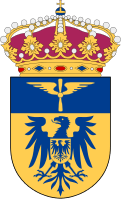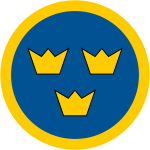Swedish Air Force Flying School
Swedish Air Force Flying School[3] (Swedish: Krigsflygskolan), also F 5 Ljungbyhed, or simply F 5, is a former Swedish Air Force training wing with the main base located in Ljungbyhed in southern Sweden.
| Swedish Air Force Flying School | |
|---|---|
| Krigsflygskolan | |
 | |
| Active | 1926–1998 |
| Country | Sweden |
| Allegiance | Swedish Armed Forces |
| Branch | Swedish Air Force |
| Type | School (1926–1976) Wing (1976–1998) |
| Part of | Chief of the Air Force (1926–1966) Southern Military Area (1966–1998) |
| Garrison/HQ | Ljungbyhed |
| Motto(s) | Docendo discimus[1] ("By teaching, we learn") |
| March | "Krigsflygskolans marsch" (Hållander)[note 1] |
| Insignia | |
| Roundels |   |
| Aircraft flown | |
| Trainer | Ö 2, Ö 4, Sk 1, Sk 3, Sk 5, Sk 6, Sk 8, Sk 9, Sk 10, Sk 11, Sk 12, Sk 14, Sk 15, Sk 16, Sk 25, Sk 50, Sk 60, Sk 61, J 28B, J 28C |
| G 101, Se 102, Se 103, Se 104, Ö 1, Ö 5, Ö 9, P 1, J 1, J 2, J 3, J 5, J 6, J 7, J 9, S 6B, Fpl 801 | |
History
The moor at Ljungby was adopted for military use in 1658 by the Scanian Hussar Regiment as a training ground. In 1910, the first flights were commenced from the grounds.
Enoch Thulin set up a public flying school on June 16, 1915.
In 1926, the newly formed Swedish Air Force set up their flying school at Ljungbyhed.
Between 1983 and 1996 the Air Force school of meteorology was also located at Ljungbyhed.
In 1996, F 5 Ljungbyhed was decommissioned and the pilot training was taken over by the Scania Air Force Wing (F 10).
Currently, Lund University School of Aviation has commercial flying training at Ljungbyhed Airport (ICAO: ESTL).
Heraldry and traditions
Coat of arms
The units first coat of arms was used until 1994. Blazon: "Azure, under three open crowns or placed two and one, an eagle wings elevated and displayed, on its breast a smaller sinister turned eagle, all or".[4] Its second coat of arms was used from 1994 to 1998 and by the Flying School at F 10 from 1998 to 2002, and by the Flying School at F 16 from 2002 to 2003 and by the Flying School at F 17 from 2003. Blazon: "Or, an eagle azure wings elevated and displayed, on its breast a shield or with a smaller sinister turned eagle azure. On a chief azure a winged two-bladed propeller or".[4]
 Coat of arms until 1994.
Coat of arms until 1994. Coat of arms from 1994 to 1998.
Coat of arms from 1994 to 1998.
Colours, standards and guidons
The units first colour was presented at F 8 at Barkarby on 6 June 1939 by His Majesty the King Gustaf V. Blazon: "On blue cloth in the centre the badge of the Air Force; a winged two-bladed propeller under a royal crown proper, all or. In the first corner, three yellow open crowns, arranged two and one".[5]
The units second colour was presented at F 5 Ljungbyhed on 25 August 1996 by His Majesty the King Carl XVI Gustaf. The colour was used as school colour at the Scania Air Force Wing (F 10) from 1 July 1998 to 31 December 2002 and at the Uppland Air Force Wing (F 16) from 1 January 2003 to 31 December 2003. The colour was drawn by Kristina Åkerberg and embroidered by machine in insertion technique by Engelbrektsson flag factory.[6] Blazon: "On blue cloth in the centre the badge of the Air Force; a winged two-bladed propeller under a royal crown proper. In the first corner an eagle, wings elevated and displayed, on its breast an escutcheon with a sinister-turned eagle. All décor in yellow".[6]
Commanding officers
Commanding officers from 1926 to 1998.[7] The commanding officer was referred to as skolchef ("chief of school") and had the rank of colonel.
- 1926–1932: Arvid Flory
- 1932–1943: Åge Lundström
- 1943–1952: Ingemar Nygren
- 1952–1957: Knut Lindahl
- 1957–1965: Åke Rehnberg
- 1965–1971: Bengt Bellander
- 1971–1975: Åke Lönnberg
- 1975–1987: Per Widmark
- 1987–1998: Sven Sjöling
Names, designations and locations
| Name | Translation | From | To | |
|---|---|---|---|---|
| Flygskolan | 1926-07-01 | – | 1929-??-?? | |
| Flygskolkåren | 1929-??-?? | – | 1936-06-30 | |
| Kungl. Flygkrigsskolan | Royal [Swedish] Air Force Flying School Royal Flying School of the [Swedish] Air Force Royal [Swedish] Air Force Flying Training School |
1936-07-01 | – | 1942-??-?? |
| Kungl. Krigsflygskolan | Royal [Swedish] Air Force Flying School[3] Royal Flying School of the [Swedish] Air Force[3] Royal [Swedish] Air Force Flying Training School[8] |
1942-??-?? | – | 1974-12-31 |
| Krigsflygskolan | [Swedish] Air Force Flying School[3] Flying School of the [Swedish] Air Force[3] [Swedish] Air Force Flying Training School[8] |
1975-01-01 | – | 1998-06-30 |
| Designation | From | To | ||
| F 5 | 1926-07-01 | – | 1998-06-30 | |
| Location | From | To | ||
| Ljungbyhed Airport | 1926-07-01 | – | 1998-06-30 |
Footnotes
- The march was adopted and established on 20 August 1984.[2]
References
Notes
- Braunstein 2005, p. 140
- Sandberg 2007, p. 41
- Gullberg 1977, p. 1442
- Braunstein 2006, p. 64
- Braunstein 2005, p. 139
- Braunstein 2004, p. 74
- Braunstein 2005, p. 141
- Appich, Jr. 1988, p. 41
Print
- Braunstein, Christian (2004). Svenska försvarsmaktens fälttecken efter millennieskiftet [The flags and standards of the Swedish armed forces after the turn of the millennium] (PDF). Skrift / Statens försvarshistoriska museer, 1101-7023 ; 7 [dvs 8] (in Swedish). Stockholm: Statens försvarshistoriska museer. ISBN 91-971584-7-X. SELIBR 9815350.CS1 maint: ref=harv (link)
- Braunstein, Christian (2005). Svenska flygvapnets förband och skolor under 1900-talet (PDF). Skrift / Statens försvarshistoriska museer, 1101-7023 ; 8 [dvs 9] (in Swedish). Stockholm: Statens försvarshistoriska museer. ISBN 9197158488. SELIBR 9845891.CS1 maint: ref=harv (link)
- Braunstein, Christian (2006). Heraldiska vapen inom det svenska försvaret [Heraldry of the Swedish Armed Forces] (PDF). Skrift / Statens försvarshistoriska museer, 1101-7023 ; 9 (in Swedish). Stockholm: Statens försvarshistoriska museer. ISBN 91-971584-9-6. SELIBR 10099224.CS1 maint: ref=harv (link)
- Gullberg, Ingvar E. (1977). Svensk-engelsk fackordbok för näringsliv, förvaltning, undervisning och forskning [A Swedish-English dictionary of technical terms used in business, industry, administration, education and research] (in Swedish) (2nd ed.). Stockholm: Norstedt. ISBN 91-1-775052-0. SELIBR 8345587.CS1 maint: ref=harv (link)
- Sandberg, Bo (2007). Försvarets marscher och signaler förr och nu: marscher antagna av svenska militära förband, skolor och staber samt igenkännings-, tjänstgörings- och exercissignaler (in Swedish) (New ed.). Stockholm: Militärmusiksamfundet med Svenskt marscharkiv. ISBN 978-91-631-8699-8. SELIBR 10413065.CS1 maint: ref=harv (link)
Web
- Appich, Jr., Thomas W. (22 July 1988). "REFERENCE AID SWEDISH-ENGLISH GLOSSARY OF MILITARY AND TECHNICAL ACRONYMS AND ABBREVIATIONS" (PDF). Joint Publications Research Service. Foreign Broadcast Information Service. Archived from the original (PDF) on 20 February 2017. Retrieved 4 February 2019.
Further reading
- Norén, Thorbjörn, ed. (1998). Sista året med Krigsflygskolan F5 (in Swedish). Ljungbyhed: Krigsflygskolan. SELIBR 2785803.
- Stridsberg, Sven (1996). Flyget i Ljungbyhed 1926-1996: Krigsflygskolan 70 år. Flyghistorisk revy, 0345-3413 ; [Specialnr 1996] (in Swedish). Stockholm: Svensk flyghistorisk fören. SELIBR 2244520.
- Stridsberg, Sven (1996). Flyget i Ljungbyhed 1927-1996: Krigsflygskolan 70 år (in Swedish). Ljungbyhed: Krigsflygskolan och Svensk Flyghistorisk Förening. SELIBR 21436742.
External links
| Wikimedia Commons has media related to Swedish Air Force Flying School. |
- Webpage listing all air force squadrons in Sweden (in Swedish)
- Current use of the airbase grounds (in Swedish)
- Article about pilot training in the Swedish Air Force (in English)